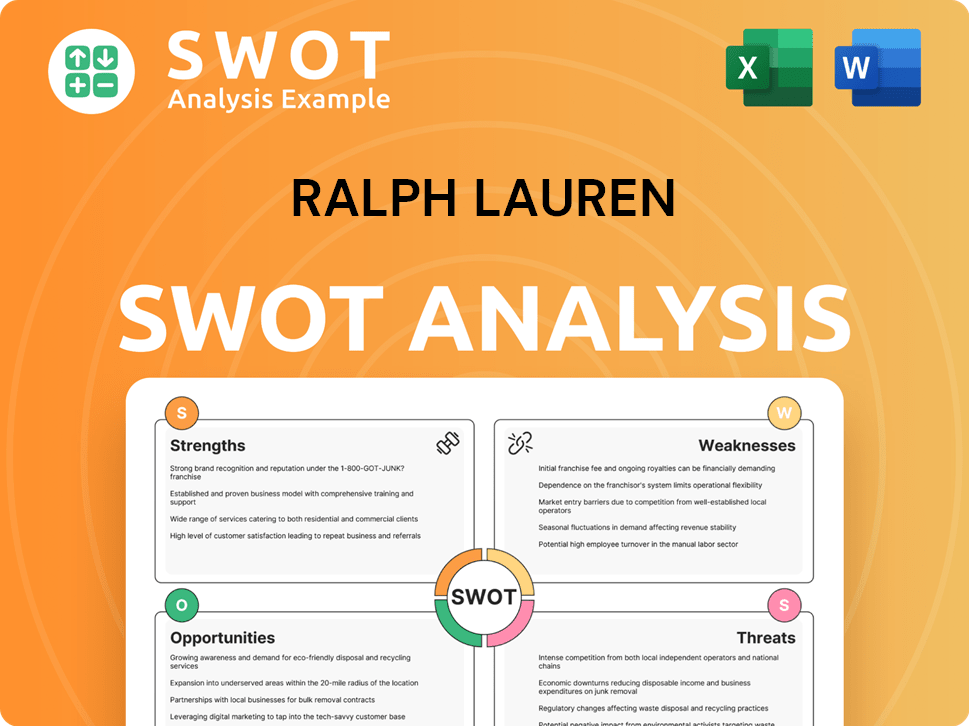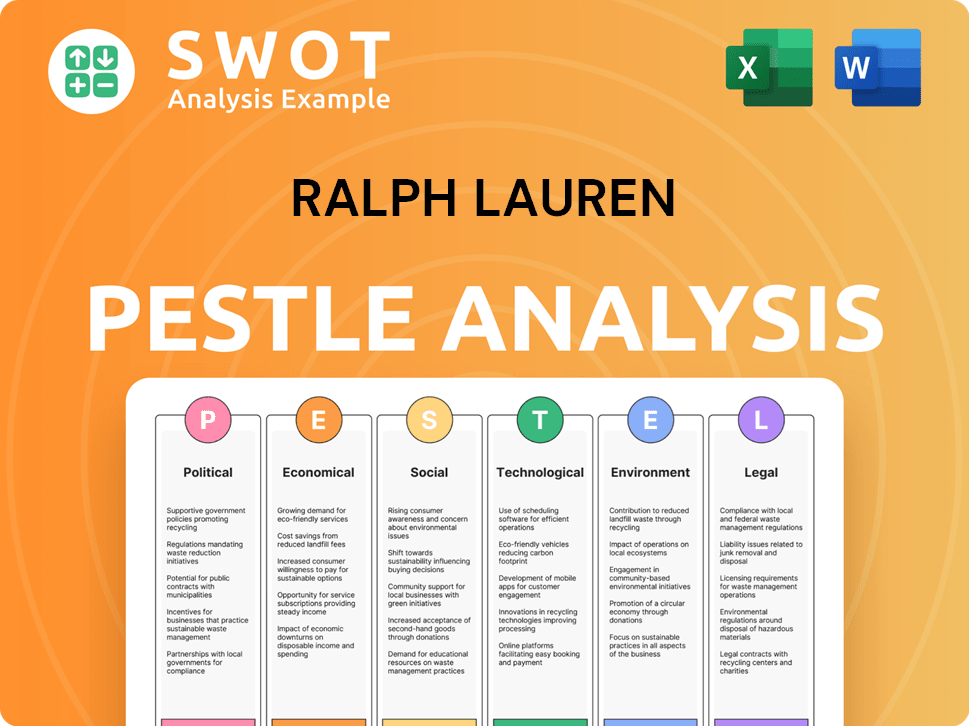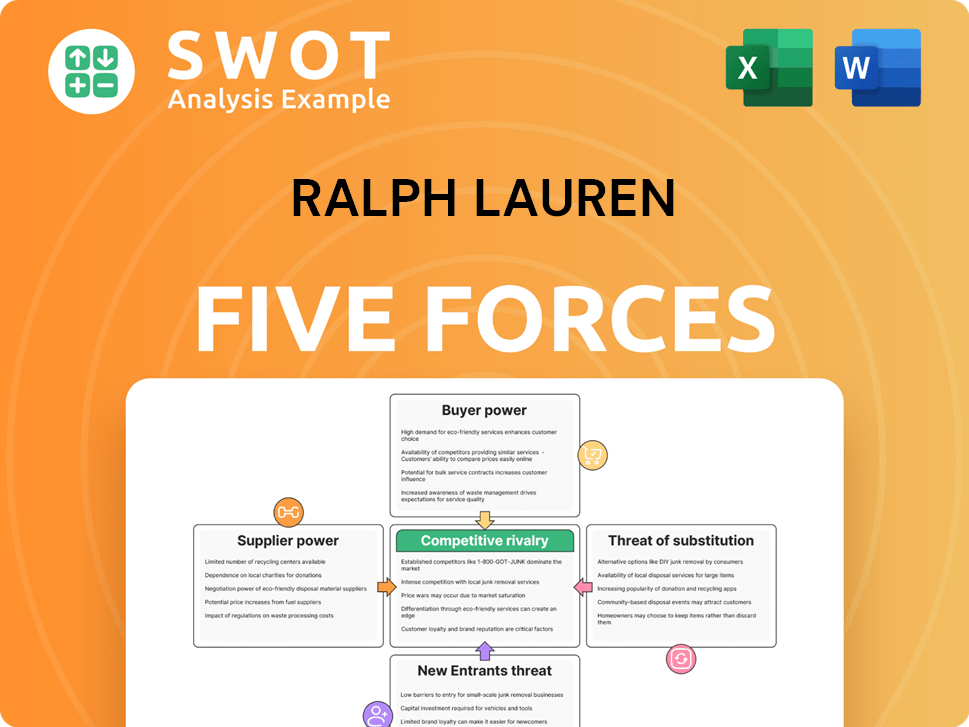Ralph Lauren Bundle
How did Ralph Lauren revolutionize American fashion?
Journey back to 1967, when a visionary named Ralph Lauren launched a brand that would redefine American style. From its inception, the Ralph Lauren SWOT Analysis reveals the strategic brilliance behind its rise. Discover how this iconic brand evolved from a collection of men's ties to a global luxury empire, leaving an indelible mark on the fashion world.

The Ralph Lauren brand's story is a testament to the power of vision and meticulous execution. Explore the early days of Ralph Lauren, the driving force behind the Polo Ralph Lauren brand, and witness how his initial designs and business strategy shaped a fashion empire. Understanding the Ralph Lauren history provides key insights into its enduring influence on American style and its key milestones.
What is the Ralph Lauren Founding Story?
The story of the Ralph Lauren Corporation begins in 1967 with Ralph Lauren, originally Ralph Lifshitz. His vision was to create a brand that embodied a classic, aspirational lifestyle. This is a brief history of Ralph Lauren, from its humble beginnings to its global presence.
Lauren, with experience from Brooks Brothers and as a tie salesman, saw an opening in the market. He aimed to offer wider, more luxurious ties, differentiating himself from the narrower styles of the time. He began his business by designing and selling these ties from a drawer in a showroom at the Empire State Building in New York City.
The company's initial name, 'Polo,' was chosen to reflect timeless elegance and the aspirational lifestyle associated with the sport of polo. This name perfectly captured his vision of a brand representing a classic, sophisticated aesthetic. Initial funding, a $50,000 loan from Norman Hilton, a clothing manufacturer, enabled Lauren to expand beyond ties into a full menswear line. This support was critical in establishing a new fashion brand in a competitive industry.
Ralph Lauren's early business model focused on high-quality, fashion-forward ties. The "Polo" brand evoked a sense of timeless elegance. The initial loan of $50,000 from Norman Hilton was crucial for expansion.
- 1967: Ralph Lauren founded the company.
- Early Designs: Focused on wider, more luxurious ties.
- Initial Funding: $50,000 loan from Norman Hilton.
- Brand Identity: The name 'Polo' was chosen to represent a classic aesthetic.
Ralph Lauren SWOT Analysis
- Complete SWOT Breakdown
- Fully Customizable
- Editable in Excel & Word
- Professional Formatting
- Investor-Ready Format

What Drove the Early Growth of Ralph Lauren?
The early growth of the Ralph Lauren brand was marked by a swift expansion, moving beyond menswear ties to a full menswear collection. This period saw the establishment of the brand's core identity and its entry into new markets. The introduction of the iconic Polo Pony logo and the launch of women's wear further solidified its position in the fashion industry.
In 1968, the first complete line of men's clothing was unveiled, broadening the scope of the Ralph Lauren offerings. This expansion was crucial for establishing the brand as a comprehensive fashion provider. It marked a significant step in the evolution of the company, moving beyond its initial focus on ties.
A major milestone occurred in 1969 when Bloomingdale's became the first department store to give Ralph Lauren a dedicated in-store boutique. This was a first for Bloomingdale's, showcasing the brand's growing influence. This move provided increased visibility and accessibility for the brand's products.
The early 1970s saw the introduction of the iconic Polo Pony logo in 1971, which became a symbol of the Polo Ralph Lauren brand. Simultaneously, the launch of the women's wear line marked the company's entry into a new product category. These developments were key to establishing the brand's identity and expanding its market reach.
The mid-1970s saw the introduction of fragrances and a home collection, solidifying the brand's status as a lifestyle brand. This strategy allowed Ralph Lauren to offer a complete lifestyle experience to its consumers. By expanding into these areas, the company created a more comprehensive brand identity.
Ralph Lauren PESTLE Analysis
- Covers All 6 PESTLE Categories
- No Research Needed – Save Hours of Work
- Built by Experts, Trusted by Consultants
- Instant Download, Ready to Use
- 100% Editable, Fully Customizable

What are the key Milestones in Ralph Lauren history?
The Ralph Lauren history is marked by significant milestones that have shaped its identity and global presence within the American fashion industry. From its humble beginnings to its current status, the brand has consistently evolved while staying true to its core values.
| Year | Milestone |
|---|---|
| 1967 | Ralph Lauren founded the company, initially selling ties under the 'Polo' label. |
| 1971 | The launch of the women's collection expanded the brand's reach and solidified its signature aesthetic. |
| 1972 | The iconic Polo shirt was introduced, becoming a symbol of the brand's identity. |
| 1983 | Diversification into home furnishings expanded the brand's lifestyle offerings. |
| 2024 | E-commerce revenue reached approximately 18% of total revenue in fiscal year 2024. |
Innovations have been central to the evolution of the Ralph Lauren brand. The creation of the 'Polo' brand was a groundbreaking move, redefining American preppy style. Further diversification into home furnishings and fragrances solidified its position as a comprehensive lifestyle brand.
The introduction of the 'Polo' brand was a pivotal innovation, setting a new standard for American preppy style.
The launch of the women's collection in 1971 broadened the brand's appeal and solidified its fashion presence.
The iconic Polo shirt, introduced in 1972, became a defining symbol of the brand's identity and a fashion staple.
Venturing into home furnishings in 1983 expanded the brand's lifestyle offerings, creating a comprehensive brand experience.
Embracing digital innovation with a robust e-commerce platform significantly contributed to revenue, reaching approximately 18% of total revenue in fiscal year 2024.
Focusing on strengthening brand elevation and digital capabilities, as evidenced by its financial performance in Q4 FY24, where revenue increased by 2% to $1.6 billion.
Navigating challenges has been an integral part of Ralph Lauren's journey. Adapting to changing consumer preferences and managing inventory in a dynamic retail environment have been ongoing concerns. Strategic restructuring initiatives, such as the 'Way Forward Plan' in 2016, aimed to streamline operations and improve profitability.
The company faces the ongoing challenge of adapting to shifting consumer tastes and preferences in the fashion industry.
Managing inventory levels effectively in a volatile retail environment is a critical operational challenge.
Increased competition from both luxury and fast-fashion brands requires constant innovation and brand differentiation.
The 'Way Forward Plan' in 2016 aimed to streamline operations and focus on core brands to enhance profitability.
Investing in digital transformation and strengthening online capabilities is crucial for maintaining market relevance.
The company focuses on strengthening its brand elevation and digital capabilities, as seen in the Q4 FY24 revenue increase of 2% to $1.6 billion.
Ralph Lauren Business Model Canvas
- Complete 9-Block Business Model Canvas
- Effortlessly Communicate Your Business Strategy
- Investor-Ready BMC Format
- 100% Editable and Customizable
- Clear and Structured Layout

What is the Timeline of Key Events for Ralph Lauren?
The Ralph Lauren history is marked by significant milestones, starting with the founding of 'Polo' in 1967. Ralph Lauren's brand expanded rapidly, introducing men's clothing lines and opening a boutique in Bloomingdale's in 1969. The iconic Polo Pony logo debuted in 1971, followed by the launch of women's wear and the classic Polo shirt in 1972. International expansion began in 1981 with the first store in London, and the Ralph Lauren Home collection was introduced in 1983. The company went public in 1997. The 2000s saw an increased digital presence, with strategic restructuring in 2016 through the 'Way Forward Plan'. In 2024, the company reported a Q4 FY24 revenue increase of 2% to $1.6 billion.
| Year | Key Event |
|---|---|
| 1967 | Ralph Lauren founded 'Polo' with a line of men's ties, marking the early days of Ralph Lauren. |
| 1968 | Introduced the first full line of men's clothing, showcasing Ralph Lauren's first designs. |
| 1969 | Bloomingdale's opened a dedicated in-store boutique for Ralph Lauren, increasing brand visibility. |
| 1971 | The iconic Polo Pony logo debuted; women's wear line launched, influencing American fashion. |
| 1972 | The classic Polo shirt is introduced, becoming a cornerstone of the Ralph Lauren brand. |
| 1981 | Opened first international store in London, expanding the company's global presence. |
| 1983 | Launches Ralph Lauren Home collection, diversifying product offerings. |
| 1997 | Ralph Lauren Corporation went public on the New York Stock Exchange, a key milestone. |
| 2016 | Announced the 'Way Forward Plan' for strategic restructuring, adapting to market changes. |
| 2024 | Reported Q4 FY24 revenue increase of 2% to $1.6 billion, indicating current financial health. |
Ralph Lauren is focusing on brand elevation to maintain its luxury positioning. Digital acceleration is a key strategy, with significant investments in e-commerce and digital marketing. This includes efforts to enhance the online customer experience and expand digital sales channels. The company is leveraging data analytics and AI to personalize customer interactions.
Geographic expansion, particularly in Asia, is a priority for future growth. The company aims to increase its presence in key international markets. This expansion includes opening new stores and strengthening its distribution networks. The strategy focuses on capitalizing on the growing demand for luxury goods in these regions.
Sustainability is a core focus, with goals to reduce environmental impact across the supply chain. This involves implementing eco-friendly practices in production and sourcing materials. The company is committed to sustainable practices, aligning with consumer preferences for environmentally responsible brands.
Analyst predictions point to continued growth in the luxury segment, which benefits the Ralph Lauren brand. The company is well-positioned to capitalize on this trend due to its strong brand equity. This includes a diversified product portfolio and strategic investments in key areas.
Ralph Lauren Porter's Five Forces Analysis
- Covers All 5 Competitive Forces in Detail
- Structured for Consultants, Students, and Founders
- 100% Editable in Microsoft Word & Excel
- Instant Digital Download – Use Immediately
- Compatible with Mac & PC – Fully Unlocked

Related Blogs
- What is Competitive Landscape of Ralph Lauren Company?
- What is Growth Strategy and Future Prospects of Ralph Lauren Company?
- How Does Ralph Lauren Company Work?
- What is Sales and Marketing Strategy of Ralph Lauren Company?
- What is Brief History of Ralph Lauren Company?
- Who Owns Ralph Lauren Company?
- What is Customer Demographics and Target Market of Ralph Lauren Company?
Disclaimer
All information, articles, and product details provided on this website are for general informational and educational purposes only. We do not claim any ownership over, nor do we intend to infringe upon, any trademarks, copyrights, logos, brand names, or other intellectual property mentioned or depicted on this site. Such intellectual property remains the property of its respective owners, and any references here are made solely for identification or informational purposes, without implying any affiliation, endorsement, or partnership.
We make no representations or warranties, express or implied, regarding the accuracy, completeness, or suitability of any content or products presented. Nothing on this website should be construed as legal, tax, investment, financial, medical, or other professional advice. In addition, no part of this site—including articles or product references—constitutes a solicitation, recommendation, endorsement, advertisement, or offer to buy or sell any securities, franchises, or other financial instruments, particularly in jurisdictions where such activity would be unlawful.
All content is of a general nature and may not address the specific circumstances of any individual or entity. It is not a substitute for professional advice or services. Any actions you take based on the information provided here are strictly at your own risk. You accept full responsibility for any decisions or outcomes arising from your use of this website and agree to release us from any liability in connection with your use of, or reliance upon, the content or products found herein.